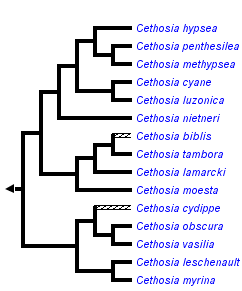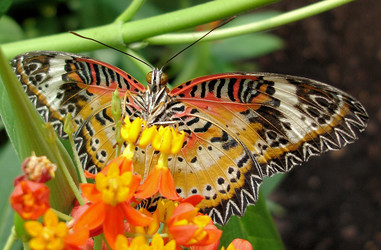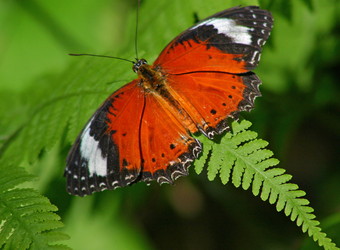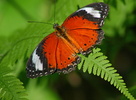Cethosia
Lacewings
Andrew V. Z. Brower


This tree diagram shows the relationships between several groups of organisms.
The root of the current tree connects the organisms featured in this tree to their containing group and the rest of the Tree of Life. The basal branching point in the tree represents the ancestor of the other groups in the tree. This ancestor diversified over time into several descendent subgroups, which are represented as internal nodes and terminal taxa to the right.

You can click on the root to travel down the Tree of Life all the way to the root of all Life, and you can click on the names of descendent subgroups to travel up the Tree of Life all the way to individual species.
For more information on ToL tree formatting, please see Interpreting the Tree or Classification. To learn more about phylogenetic trees, please visit our Phylogenetic Biology pages.
close boxIntroduction
A genus ranging from India across Indonesia to New Guinea, northern Australia and the Solomons. Many of the species are widely distributed and exhibit substantial geographical variation. Gregarious larvae feed on Adenia and other non-native taxa in (Passifloraceae).
Adults of some species are sexually dimorphic.Discussion of Phylogenetic Relationships
The tree shown above is based upon the consensus cladogram (Fig. 3) of M?ller and Beheregaray (2010), inferred from sequences of mitochondrial COI and ND5, and wingless genes. Note that three geographically widespread and variable species, C. hypsea, C. cydippe and C. biblis, are paraphyletic according to this hypothesis.References
M?ller CJ. 1999. A new species of Cethosia and a new subspecies of Delias (Lepidoptera: Nymphalidae and Pieridae) from montane New Ireland, Papua New Guinea. Austr. Ent. 26: 65-70.
M?ller, C.J.,Beheregaray, L.B. 2010. Palaeo island-affinities revisited - biogeography and systematics of the Indo-Pacific genus Cethosia Fabricius (Lepidoptera: Nymphalidae). Mol. Phylogenet. Evol. 57: 314-326.
Parsons M. 1999. The butterflies of Papua New Guinea: their systematics and biology. Academic Press, San Diego.
Vane-Wright RI, and de Jong R. 2003. The butterflies of Sulawesi: annotated checklist for a critical island fauna. Zoologische Verhandelingen 343: 1-267.
Title Illustrations

| Scientific Name | Cethosia hypsea, Asclepias curassavica |
|---|---|
| Location | Butterfly house, Vienna, Austria; native to South-East Asia |
| Specimen Condition | Live Specimen |
| Source | Cethosia hypsea |
| Source Collection | Flickr |
| Image Use |
 This media file is licensed under the Creative Commons Attribution-NonCommercial-ShareAlike License - Version 2.0. This media file is licensed under the Creative Commons Attribution-NonCommercial-ShareAlike License - Version 2.0.
|
| Copyright | © 2006 Gertrud Kanu |
| Scientific Name | Cethosia cyane |
|---|---|
| Location | captive |
| Comments | The Australian Butterfly Sanctuary in Kuranda is home to over 1500 magnificent tropical butterflies, all local to the area, including the electric blue Ulysses butterfly and the largest butterfly in Australia, the Cairns or Australian Birdwing. |
| Specimen Condition | Live Specimen |
| Sex | Male |
| Source | C?thosia Cyane male / Malay Lacewing |
| Source Collection | Flickr |
| Image Use |
 This media file is licensed under the Creative Commons Attribution-NonCommercial-NoDerivs License - Version 2.0. This media file is licensed under the Creative Commons Attribution-NonCommercial-NoDerivs License - Version 2.0.
|
| Copyright | © 2006 Gary Hayes |
About This Page

Middle Tennessee State University, Murfreesboro, Tennessee, USA
Correspondence regarding this page should be directed to Andrew V. Z. Brower at
Page copyright © 2011
 Page: Tree of Life
Cethosia . Lacewings.
Authored by
Andrew V. Z. Brower.
The TEXT of this page is licensed under the
Creative Commons Attribution License - Version 3.0. Note that images and other media
featured on this page are each governed by their own license, and they may or may not be available
for reuse. Click on an image or a media link to access the media data window, which provides the
relevant licensing information. For the general terms and conditions of ToL material reuse and
redistribution, please see the Tree of Life Copyright
Policies.
Page: Tree of Life
Cethosia . Lacewings.
Authored by
Andrew V. Z. Brower.
The TEXT of this page is licensed under the
Creative Commons Attribution License - Version 3.0. Note that images and other media
featured on this page are each governed by their own license, and they may or may not be available
for reuse. Click on an image or a media link to access the media data window, which provides the
relevant licensing information. For the general terms and conditions of ToL material reuse and
redistribution, please see the Tree of Life Copyright
Policies.
- First online 11 November 2006
- Content changed 26 February 2011
Citing this page:
Brower, Andrew V. Z. 2011. Cethosia . Lacewings. Version 26 February 2011 (under construction). http://tolweb.org/Cethosia/70394/2011.02.26 in The Tree of Life Web Project, http://tolweb.org/









 Go to quick links
Go to quick search
Go to navigation for this section of the ToL site
Go to detailed links for the ToL site
Go to quick links
Go to quick search
Go to navigation for this section of the ToL site
Go to detailed links for the ToL site